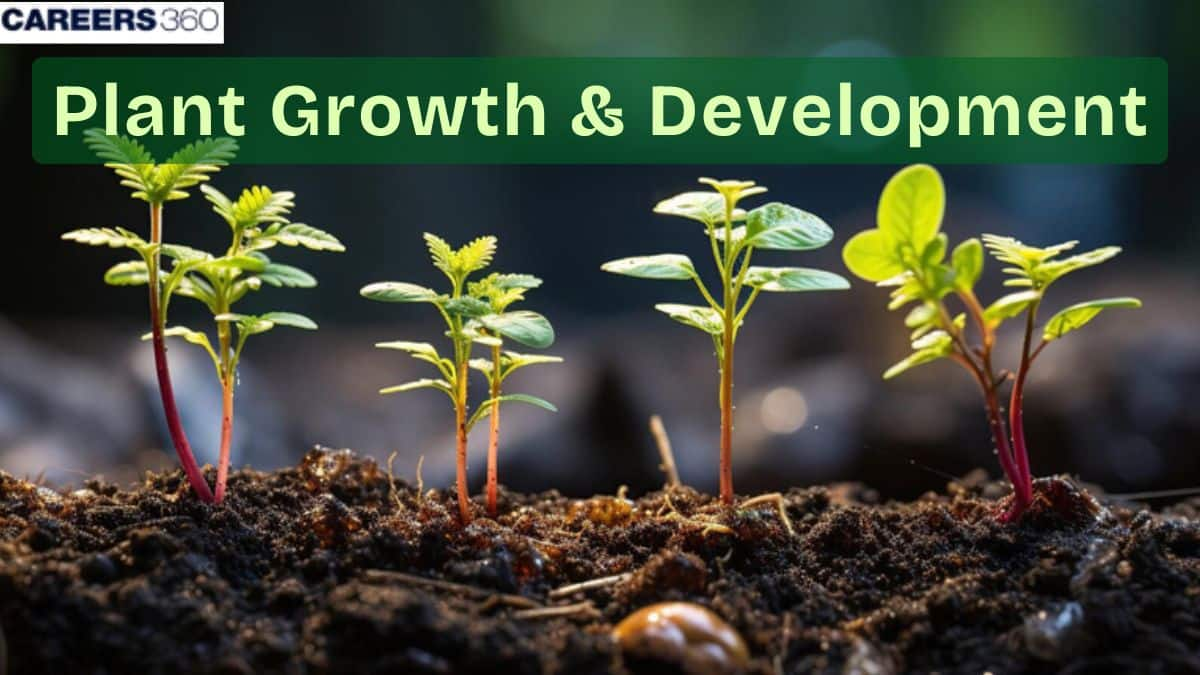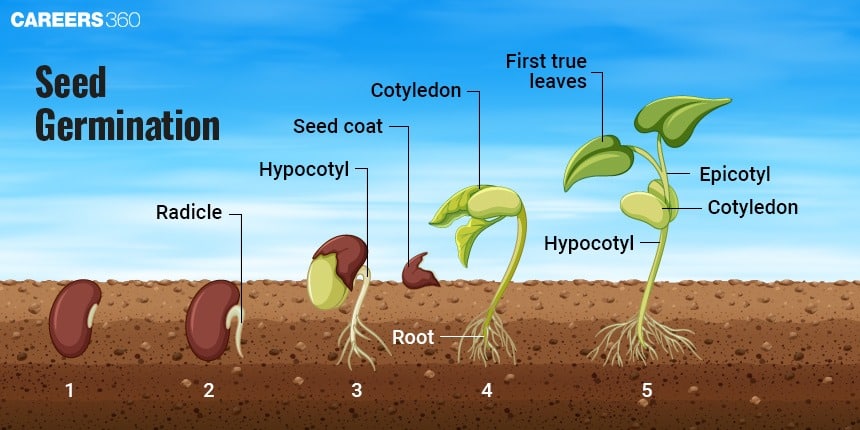Plant Growth and Development: Topics, Overview, Phases, Factors, Books, Tips, Questions
Plant growth is a permanent, irreversible increase in size, mass, and cell number, powered by cell division, enlargement, and differentiation. It occurs throughout a plant’s life due to meristems and is influenced by hormones, environmental factors, and genetics. Understanding plant growth phases is crucial for NEET and Class 11 Biology.
This Story also Contains
- What Is Plant Growth?
- Key Processes In Plant Growth
- Phases Of Plant Growth
- Environmental Factors Affecting Plant Growth
- Differentiation in Plant Growth & Development
- Role of Differentiation in Adaptation
- Plant Growth & Development NEET MCQs (With Answers & Explanations)
- Recommended video on "Plant Growth and Its Development"

What Is Plant Growth?
Growth can be defined as a permanent increase in the size and mass of a plant and involves cellular enlargement and cell division. Development would then be the series of events that happen in the life history of a plant from germination through flowering, fruiting, and senescence. In this context, development will be key to the mere existence of a plant and reproductive success since it allows plants to produce seeds for the next generation.
Various factors influence the growth and development of plants. Among which, some are controllable or uncontrollable to man like the genetic make-up, the environmental conditions such as light, temperature, water, and nutrients, and hormonal regulation. Knowing and understanding all these would be of much help in maximizing these agricultural practices for the sake of healthy plant development.
Key Processes In Plant Growth
Cell division is the basis of growth in plants.
Cell Division
Role of Mitosis and Meiosis
Mitosis results in a process in which one cell divides and gives rise to two identical daughter cells that are mirror images of each other, and the mother cell—process is used to help in growth, repairing, and amoebic or asexual reproduction in plants. Conversely, meiosis takes place in the reproductive organs of the organism and varieties of gametes, that is, the sperm and egg, to quickly enhance the ability of the species to carry on with the sexual means of reproduction.
Prophase: The chromosomes begin to condense and may now be visible.
Metaphase: The chromosomes orient themselves at the cell's equatorial plate.
Anaphase: Sister chromatids separate, moving toward opposite poles.
Telophase: Nuclear membranes re-establish around each set of chromosomes.
Cytokinesis: The cleavage of the cell into two separate daughter cells.
Cell Enlargement
Mechanism of Cell Enlargement
The cells take up water, increase in volume, and tend to force the cell walls from outside during cell turgor pressure. This is due to the water intake in the central vacuole, which causes the swelling of the cell.
Role of Turgor Pressure
Turgor pressure is the pressure exerted on the cell wall by the cell membrane. When this is absent, the cells are flaccid. It is therefore responsible for the stiffness of cells, hence cell enlargement. It is the result of the osmotic flow of water into a cell and it provides the force for cell growth, leading to the extension of plant tissues.
Cell Differentiation
Definition and Importance
Cell differentiation is a process in which the cells are cast into different classes of cells, each having distinct functions. This makes the process of cell differentiation indispensable for the development of tissues and organs which helps a plant carry on several of these kinds of complex activities like nutrient absorption, photosynthesis, and reproduction later on.
Example: Differentiation in Root and Shoot Systems
In the root system, cells differentiate into root hair cells, thus expanding the surface area for the absorption of water and nutrients. In the shoot system, cells differentiate into a variety of cell types, including xylem and phloem cells that function in water and nutrient transport and photosynthetic cells in leaves.
Phases Of Plant Growth
There are various stages of Plant Growth.
Germination
Stages of Seed Germination
Imbibition: The seed imbibes water, swells, and the seed coat cracks.
Activation: Metabolic processes go active, enzymes are activated, and stored food reserves are mobilized.
Emergence of Radicle: First, the root appears and anchors the seedling. The radicle then begins to take in water and nutrients.
Emergence of Plumule: The shoot is next to appear, growing directionally toward the light
Factors Affecting Germination
Water: Important for the process of imbibition and the activation of enzymes.
Oxygen: this is required to provide energy for growth by respiration.
Temperature: It requires an optimum temperature for enzyme activity.
Light: Many seeds germinate in response to light, others in darkness.
Vegetative Growth
Definition and Characteristics
Vegetative growth can be described as the stage at which the plant's development becomes more considerable and more covering of root, stem, and leaf growth. This undertaking is at a sensitive period when the tough frame that eventually will support reproductive growth is put in place.
Role of Meristems
Apical Meristems: Found in the root and shoot apices, they account for primary growth, for elongation.
Lateral Meristems: The vascular and cork cambium; account for secondary growth; for thickening.
Intercalary Meristems: Found in the base of leaf blades or internodes, the cause for grass to sprout
Reproductive Growth
Vegetative to the Reproductive Phase
The process is accompanied by alteration of gene expression and hormonal regulation and concludes with flowers, fruits, and seeds. The transition is often environmental, induced by stimuli such as light, temperature, and photoperiod, among others.
Flowering and Fruiting
Flowering is the formation of flowers. These are essentially the sexual organs of the plant. In fruiting, the fruits in post-fertilization, are structures that primarily protect the seeds but aid in their dispersal as well.

Environmental Factors Affecting Plant Growth
The environmental factors affecting the plant growth are:
Light
Light is one of the factors in photosynthesis, which is the process by which plants transform light energy into chemical energy to synthesize glucose and oxygen. Photoperiodism is responsible for the control of flowering, seed germination, and other developmental processes and is considered as the plant response to the length of day and night
Water
Water maintains cell turgor and hence keeps the cells turgid, providing the plant with the erect form it holds. Water further acts as a solvent that acts in nutrient translocation between different parts of the plant through the xylem and phloem.
Effects of Water Deficiency and Excess
Water Deficiency: It results in wilting, stunted growth, and hampers physiological activities.
Water Excess: Root rotting, oxygen lack in the soil, and inhibition of nutrient uptake.
Temperature
Temperature essentially changes the rate at which the enzymatic activities within the plants occur, affecting the growth and development of organisms. The optimal temperature ranges allow the maximum efficiency of the enzymatic activities and growth rate. Temperatures above or below could completely inhibit these functions from occurring altogether.
Nutrients
Plants need some macronutrients, such as nitrogen, phosphorus, and potassium, and other nutrients such as iron, manganese, and zinc, which are micronutrients, for development and to grow. These nutrients have their functionality in the physiological process.
Soil fertility can be defined as a state where soil possesses all the required nutrients for plant growth. Such a soil with required nutrients will support the profuse growth of plants by developing a healthy competent root system that can pick up the required nutrients from the environment at a fast rate.
Differentiation in Plant Growth & Development
Differentiation is a process by which nonspecialized cells get to be specialized to perform distinct functions. It is the process of development which is important to develop most tissues and organs of plants. This gives way to complex structures and functions.
Examples
Collenchyma Cells: They provide support and elasticity to young stems and leaves, respectively.
Sclerenchyma Cells: They provide mechanical support and strength with thick and lignified cell walls.
Vascular Tissue: xylem cells differentiate to conduct water and minerals while conducting sugars and other organic compounds is done by the phloem.
Specialize – leaves mesophyll cells to – palisade parenchyma photosynthesis, spongy parenchyma perform exchange of gases
Role of Differentiation in Adaptation
The role of differentiation in adaptation includes:
Leads to the formation of specialised structures like leaves, stems, and roots; in further vascular plants, it also leads to reproductive organs.
A means of adjustability to the environment, where cell differentiation enables the plant to develop its cells of a particular kind
Plant Growth & Development NEET MCQs (With Answers & Explanations)
Important topics for NEET are:
Key processes in Plant Growth
Phases of Plant Growth
Environmental factors
Practice Questions for NEET
Q1. The occurrence of more than one type of leaves in rooted emergent water plant is known as
Phyllotaxy
Heterophylly
Aestivation
Anisophylly
Correct answer: 2) Heterophylly
Explanation:
The occurrence of multiple leaf types in rooted aquatic plants is termed heterophylly. This phenomenon is categorized into three distinct types:
1. Developmental Heterophylly: This involves the formation of varied leaf types during different growth phases of the plant, such as juvenile and adult stages.
2. Environmental Heterophylly: Here, leaf morphology is influenced by external conditions, with specific leaf types developing in response to environmental factors like water depth. For instance, submerged leaves might differ from those that emerge above water.
3. Habitual Heterophylly: In this case, the plant exhibits dissimilar leaf types across various regions of its structure, such as underwater, floating, and above-water parts.
Examples of heterophylly can be seen in species like Potamogeton and water lilies. These emergent water plants have large, broad leaves that extend above the water surface for photosynthesis. In contrast, their submerged leaves are often more intricately divided or structurally adapted to enhance their functionality within the water column. This dual-leaf strategy allows them to efficiently inhabit and thrive in their aquatic surroundings.
Hence, the correct answer is option 2) Heterophylly.
Q2. Plants display
Definite growth
Indefinite growth
Fixed growth
Steady growth
Correct answer: 2) Indefinite growth
Explanation:
Having meristems—areas of actively dividing cells—allows plants to expand indefinitely. Located at the tips of roots and shoots, these meristems enable plants to continue developing for the duration of their lives. By becoming taller, extending their roots, or spreading their branches as necessary, this kind of growth aids plants in adjusting to their surroundings.
Hence, the correct answer is option 2)Indefinite growth.
Q3. What happens to seeds when favourable conditions for growth are absent?
They grow rapidly
They enter a period of suspended growth or rest
They continue metabolic activities
They form roots
Correct answer: 2) They enter a period of suspended growth or rest
Explanation:
Seeds enter a period of dormancy or rest when conditions for growth are not favourable, such as in the absence of adequate moisture, temperature, light, or oxygen. During dormancy, metabolic activities in the seed are greatly reduced, and the seed remains in a state of suspended growth. This dormancy period is a survival mechanism, allowing the seed to wait for optimal environmental conditions before beginning germination. The seed coat, hormones like abscisic acid (ABA), and other factors regulate this dormant state. Once the conditions are favourable, such as when water, temperature, and light signals are appropriate, the seed can overcome dormancy and begin the germination process.
Hence, the correct answer is option 2) They enter a period of suspended growth or rest
Also Read:
Recommended video on "Plant Growth and Its Development"
Frequently Asked Questions (FAQs)
Plant growth is a process characterised by the irreversible change in the size of cells and plant parts that is a result of cell division and enlargement. Plant development is the process of progression from seed germination to maturation.